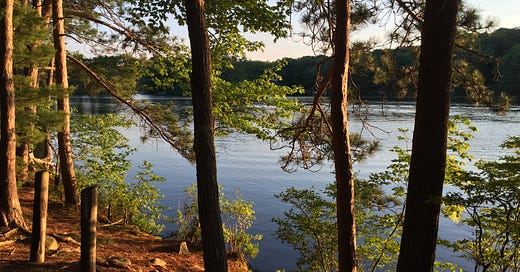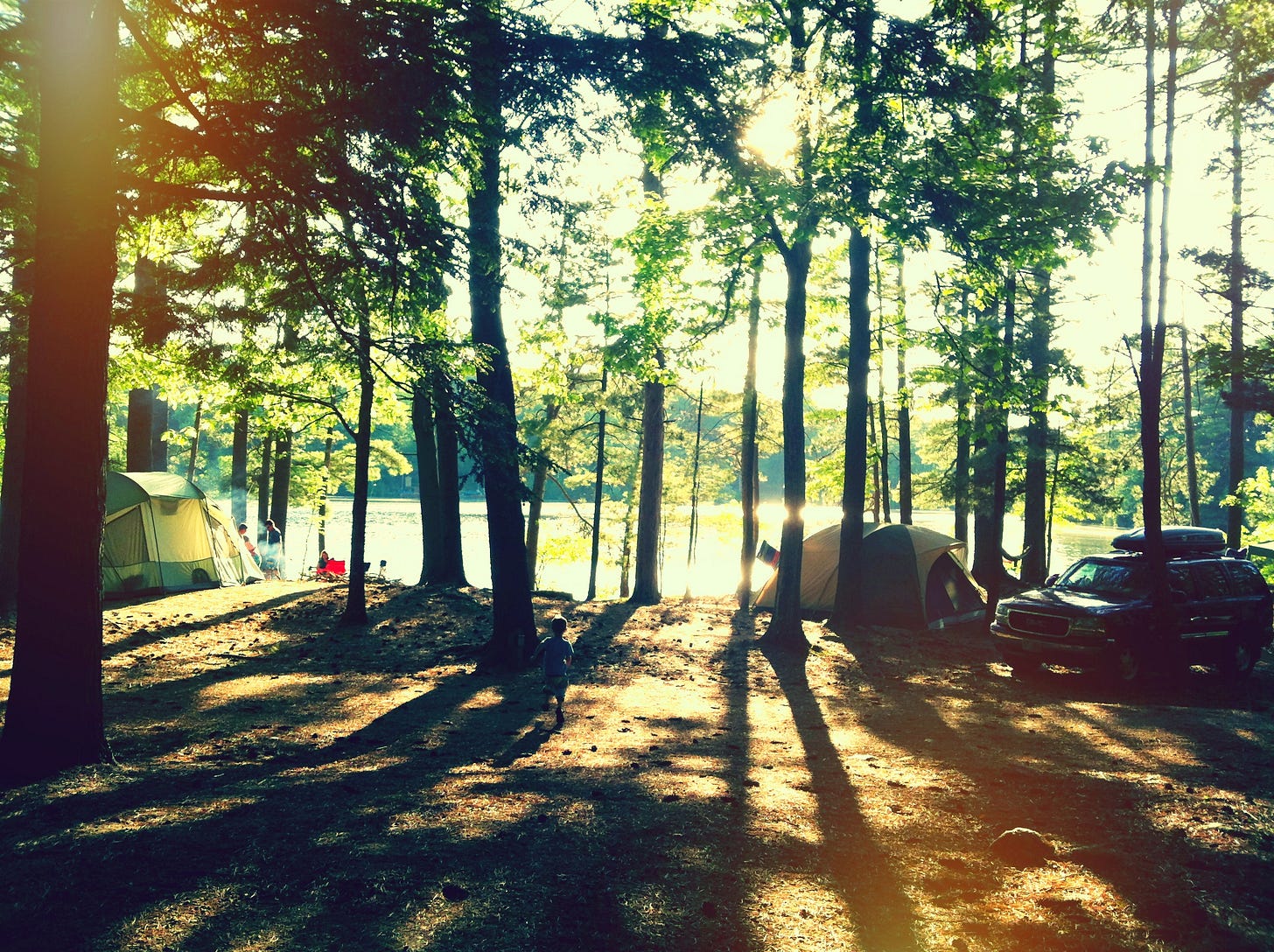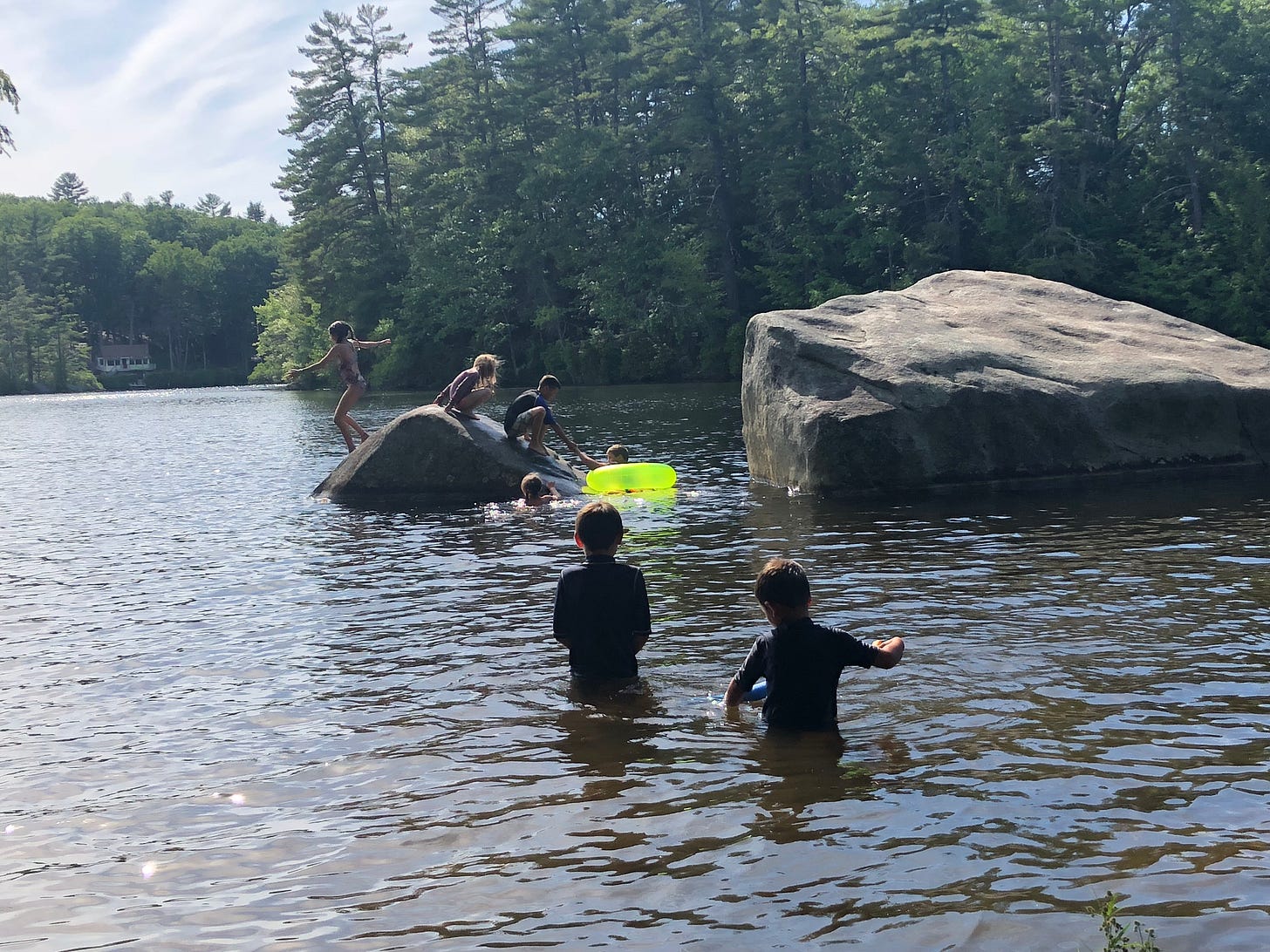Last weekend, D and I drove up to a campground in New Hampshire. It is a state park, complete with a beautiful lake and picnic area for families to come and enjoy the summer with food, swimming, and community. We first discovered this gem when the boys were still quite small. Friends had recommended this spot, noting in particular a small cove that holds only 19 sites, nine of which are lakefront and absolutely gorgeous. The cove is wooded and serene, the floor softened by the paprika-colored bed of pine needles. Roots, gnarled and burnished by years of barefeet—big and small—walking over them, add texture and beauty to the forest floor. All those years ago, we packed up our tent; sleeping bags; duffle bags full of clothes; our bins full of plastic utensils, plates, bowls, cups, marshmallow and hot-dog roasting poles, a pot and a pan borrowed from our kitchen, food staples for the weekend; bug spray and suntan lotion; flashlights and glow sticks; and whatever else we thought of to move our lives outside for a few days. It was only our second or third camping trip, so we had not yet achieved the level of organization that would come later—with lists to make the preparation easier and the trip more seamless. Our site was not lake front—those weren’t available and would have been too much to manage with a 2 year old, 4 year old, and 7 year old, none of whom were strong swimmers.
That first trip, over a hot Memorial Day weekend, we all fell in love with the little cove and the expansive lake, shimmering in the sunlight with a thousands points of sparkling sunlight reflecting off of it. We rented a canoe and paddled around to the various little islands, perfect for little explorers who delighted in finding frogs and mushrooms and interesting bark. It would be a few years before the boys would captain their own kayak; jump off the big rock into the cold, New England lake water; run through the woods at night with neighbors playing SlenderMan. During COVID, D took the boys up with several of their friends, the outdoors offering them the socializing and togetherness the pandemic had robbed them of. Every summer, we found ourselves back at the cove, adding more and more families to our outdoor community every year. It was a time of shared food, card games, stories, laughter, and connection.
As with so many other things, getting a site at this campground has become increasingly challenging. Booking opens up 11 months prior to the reservation date and a whole method has been established to ensure the coveted lakefront sites are reserved. Our last family trip had been in June 2022, and last summer, D, hopeful that we might get in another family trip, booked us our favorite site. The boys declined to come with us, so D and I headed up the familiar highway into the woods of New Hampshire.
The weather has been challenging this spring and early summer. We hit the 13th consecutive rainy Saturday on June 14th, breaking the previous record of 12. We were lucky to arrive at the campsite on Friday afternoon, June 20, to the promise of a glorious stretch of weekend weather. As we decided where to put the tent and looked around at the familiar view, memories of the past 13 or so years ebbed in, like the gentle waves of the lake, lapping up the shore. That Friday we arrived and sat in the minivan waiting out the rain, watching the dips in the land fill up with water. The little voices pleading for accompaniment to the camp store and then later, for money to go with friends. The excitement when someone caught a frog. The many rounds of Yahtzee, Quirkle, Uno, and other games played on a picnic table covered with the bold, red and white gingham tablecloth thick with a flannel backing that fuzzes over the course of the camping trip. The many conversations with my dear friend and neighbor, whose family has been on probably 80-90% of our trips to this spot and whose children are folded into the memories of my own children’s childhood. The simple pleasure of having one of her girls braid my unruly hair. The sound of children clamoring up on the rock, the splash as their bodies made contact with the water. The way time pauses and the choices in front of you are about how you will interact with nature—water, forest trail, or simply taking it all in from your camp chair or hammock.
The cool, breezy nights warmed by the glow of the fire, the mesmerizing effects of watching the colors start in shimmery flashes of blue closest to the wood, melting into the white hot flame just below the dancing yellow flame. The yellow making up most of the excited ions, burning in a flickering, gaseous blaze, with edges and tips of orange and even red. Watching the way that heat transforms a log into a burst of pure color, all while producing intense warmth. How many times had I been lost in that sight, in following the way the flame seemed to curl and bend, moving to some unheard soundtrack, providing a rhythmic dance as enchanting as any human performance. It is an experience that can only be had in person.
The two days we spent this spectacular June weekend, hiking through the woods—walking rapidly as we could to escape the constant attack of mosquitos—paddling along in the lake, sitting by the campfire, reading in the hammock, eating much-too-large dishes of mango Dole Whip—were blissful and nostalgic. In that place, the memories of my boys growing up were held so tenderly. Tears flooded my eyes many times as I recalled my boys growing up in these woods, on this lake, held with such love by our neighborhood community. The quiet and peacefulness I often chased during those busy years of camping with young boys was present this past weekend. And while I loved the easiness, the slow pace of the day with only the two of us to confer on what to do and when, I, of course, missed the chatter, the input, the liveliness of our little family, our neighbors, our community.
Sunday morning, we woke up to unexpected rain and that rush to pack up before a forecasted thunderstorm that never materialized set off a week of challenges. The heat and humidity—record-breaking in our area and so many others across the country, a malfunction in the air conditioning at my office, a stiff neck, dealing with some heavy emotions in therapy sessions, seasonal allergies that never seem to quit, another week of Washington chipping away at the structures that uphold our country’s commitment to its people all left me drained and exhausted by Thursday evening. Although I generally think of myself as tough and flinty, summer heat and humidity leave me wilting and weak. Though the temperatures dropped dramatically Wednesday night into Thursday morning and the breeze coming through the finally opened windows was divine, by the time I finished work, the idea of doing much more than cooking dinner was daunting. The alerts coming through about the SCOTUS decisions on Friday pierced the carefully constructed barrier between my focus on the day to day and the news. All of it—the unbearable heat and heavy heavy humid air; the pollen levels continuing to be very high and my immune system’s overreaction to this continued irritant; the senseless persecution of people; the assault on common sense, on science, on decency, on kindness—it felt more than I could hold at this moment.

Humid air holds nitrogen and hydrogen in addition to oxygen. We have to work harder to get the needed oxygen out of the air to breathe. Additionally, because the air is already so heavy with water, our usual method of cooling our bodies down—sweating—is far less effective because the sweat can’t evaporate off our on skin. In extreme conditions, it can lead to heat exhaustion or heat stroke. As the planet has warmed over the past 40 years, nighttime temperatures haven’t been dropping as much, giving us little time to recover from the relentless heat. Add to this the additional challenges of temperature regulation that comes with perimenopause, and well…you have a wilted, miserable me.
These past several months, I have been trying to find the balance between wondering if we are in the collapse and creating an island of sanity, focusing on the present and what I can do to live with insight and compassion and not getting pulled into the endless news cycle of violence, aggression, and hatred meted out to fill a handful of billionaire’s insatiable need for power and money. It’s a hard line to walk.
It’s a surreal line to walk.
How can I pull weeds in my garden and listen to an audiobook when a genocide is occurring 5,500 miles from me? How can I focus on figuring out what colleges my 17 year old should visit when a high school student was kidnapped by ICE on his way to volleyball practice not even 50 miles from me? How can I make plans for starting a new training position for August 2026 when it is unclear what the federal work force will look like this fall, let alone next year? This type of dissonance was described by Alexei Yurchak in relation to Soviet Russia. He called it hypernormalization. Digital anthropologist, Rahaf Harfoush describes it this way: “it’s the visceral sense of waking up in an alternate timeline with a deep, bodily knowing that something isn’t right—but having no clear idea how to fix it.” Sadly, it too clearly captures what it is to live in the US in 2025.
A few months ago, I heard the phrase extravagant tenderness and felt a deep resonance with this phrase, a sense that the aching and searching for what I was feeling, what I was sensing about this moment, was captured in the sentiment these words represented. This is what we need in this moment, what we are yearning and searching for, and somehow, pulling ourselves further and further away from each other in this pursuit. In his decades working with gang- and justice-involved youth in Los Angeles, Father Gregory Boyle summarizes what he has learned: “love is the answer, community is the context, and tenderness is the connective tissue.” Extravagant tenderness is what can bring us back to each other..
When my plants wilt, regular watering pulls their droopy stems upright, the sad flowers perk back up. When my heart feels heavy with the ills of the world, a walk in the woods alone or with friends lightens that load and my path feels clearer. When it’s hot and humid outside, we have to slow down and have different expectations of what we can accomplish. We have to limit our exposure to the heat, we increase our time inside. We adapt. When our culture feels so divided and angry, the antidote is to lean even further into tenderness, to the boundless love and compassion we, as humans, are capable of giving and receiving. The kind of love I feel for my children. The kind of love that was evoked as the memories of years spent sharing a weekend living in community with our neighbors washed over just last weekend. The kind of all-encompassing compassion I feel for my clients when they share with me the most vulnerable and exquisitely tender parts of their lives. The gentleness with which I held my tiny newborns, just waking in this harsh world. The tight, long embrace when I hug a grieving friend. The careful, deliberate words I offer to create a container to hold the painful truths a client bravely shares.

Margaret Wheatley said in an interview, when we see a glass of water, the question is not is it half full or half empty, but rather, there is water here. Who needs it and how can I get it to them? When I am at work, focused on what I can do to make even a small difference in someone else’s life, the existential dread about things I can’t control fades into the background and the person with whom I am working is full frame.
When we choose to love, we are also choosing loss. Life follows the same cycles that we see all around us. The seasons change. Every year. Springing bringing new life, summer bringing warmth and verdant, lush greenery. Autumn showing us the glory of letting go. And winter, the necessity of quiet and rest. We watch a flower push up with a small green shoot. With the right conditions, that shoot grows into a stem and produces a tight bud. With water and nutrients and sun, that bud blossoms and shares its beauty with the world. Eventually, the blossom wilts and falls off, the stem continuing to soak up nutrients to feed the plant for the next year. Finally, the stem itself will yellow and disintegrate, fading back into the earth. And the cycle begins again. I have seen my boys from the beginning of their life cycle, now growing into their independence and adulthood. I see my own life cycle closer to its end than its beginning.
I don’t know where our country, our planet is on its trajectory. I don’t know if this is a transition or a collapse. What I do know is that it is far bigger than me. What is here, in front of me, are the choices that I can make about my own life. Whether I see the glass of water and consider who most needs that drink and whether I can deliver it to them. Whether I can bring extravagant tenderness to my work, my community, my friends, my family, myself. Whether I choose hope.
The kind of hope I often think about (especially in situations that are particularly hopeless, such as prison) I understand above all as a state of mind, not a state of the world. Either we have hope within us or we don’t; it’s a dimension of the soul; it’s not essentially dependent on some particular observation of the world or estimate of the situation. Hope is not prognostication. It is an orientation of the spirit, an orientation of the heart; it transcends the world that is immediately experienced, and is anchored somewhere beyond its horizons. Hope, in this deep and powerful sense, is not the same as joy that things are going well, or willingness to invest in enterprises that are obviously headed for early success, but, rather, an ability to work for something because it is good, not just because it stands a chance to succeed. ~Rebecca Solnit, Hope in the Dark
When I walk in the woods near my house, hike a mountain in New Hampshire, float in a kayak or paddle board in a pristine lake, I am there, in the present moment. Nature creates a space that is separate from the systems and structures humans have created, from the competitions we have set up to strive continually for more and more and more, without consideration of the cost to our communities, our planet. To each other. That space is easily accessible from the time my boot hits the soft pine-needle covered floor and the sky is blocked by the leafy canopy. I can feel the letting go, the easing into the here and now, the ability to just be.
And that space exists between a mother and her child, between friends sharing the joys and pains in their lives, between a healer and one seeking healing, within a community of people working together to create a life built on hope. A life filled with boundless compassion, radical kinship, and extravagant tenderness offered to everyone, without a hierarchy of deservedness.
As we navigate this time of hypernormalization, as the ways in which the destructive whims of our political leaders encroach more and more on our personal lives, I will continue to focus on who I am, why I am here, and what I hope to accomplish with my one short life.
I will continue to love, heart open, like it matters, like the world depends on it.
Because it really does.
Because
So I can’t save the world—
can’t save even myself,
can’t wrap my arms around
every frightened child, can’t
foster peace among nations,
can’t bring love to all who
feel unlovable.
So I practice opening my heart
right here in this room and being gentle
with my insufficiency. I practice
walking down the street heart first.
And if it is insufficient to share love,
I will practice loving anyway.
I want to converse about truth,
about trust. I want to invite compassion
into every interaction.
One willing heart can’t stop a war.
One willing heart can’t feed all the hungry.
And sometimes, daunted by a task too big,
I tell myself what’s the use of trying?
But today, the invitation is clear:
to be ridiculously courageous in love.
To open the heart like a lilac in May,
knowing freeze is possible
and opening anyway.
To take love seriously.
To give love wildly.
To race up to the world
as if I were a puppy,
adoring and unjaded,
stumbling on my own exuberance.
To feel the shock of indifference,
of anger, of cruelty, of fear,
and stay open. To love as if it matters,
as if the world depends on it.
~Rosemerry Wahtola Trommer
All photos were taken by the exceptional Dana Giuliana, unless otherwise noted.
Thanks for spending some of your day reading this post. I hope it resonated. Periplum of motherhood and other wonderings is free. If you enjoy reading, please share it with friends!








We are in this together, as one🙏